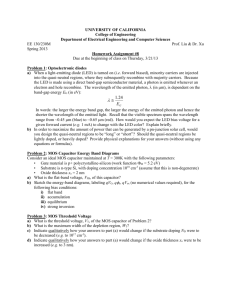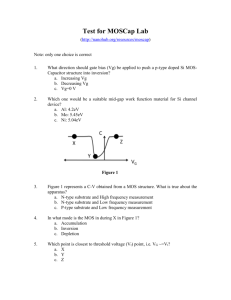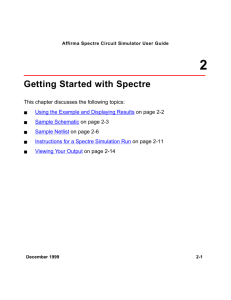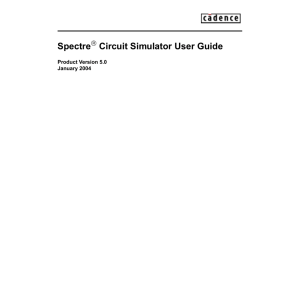The basic theory behind Monte Carlo Simulation observe the
advertisement
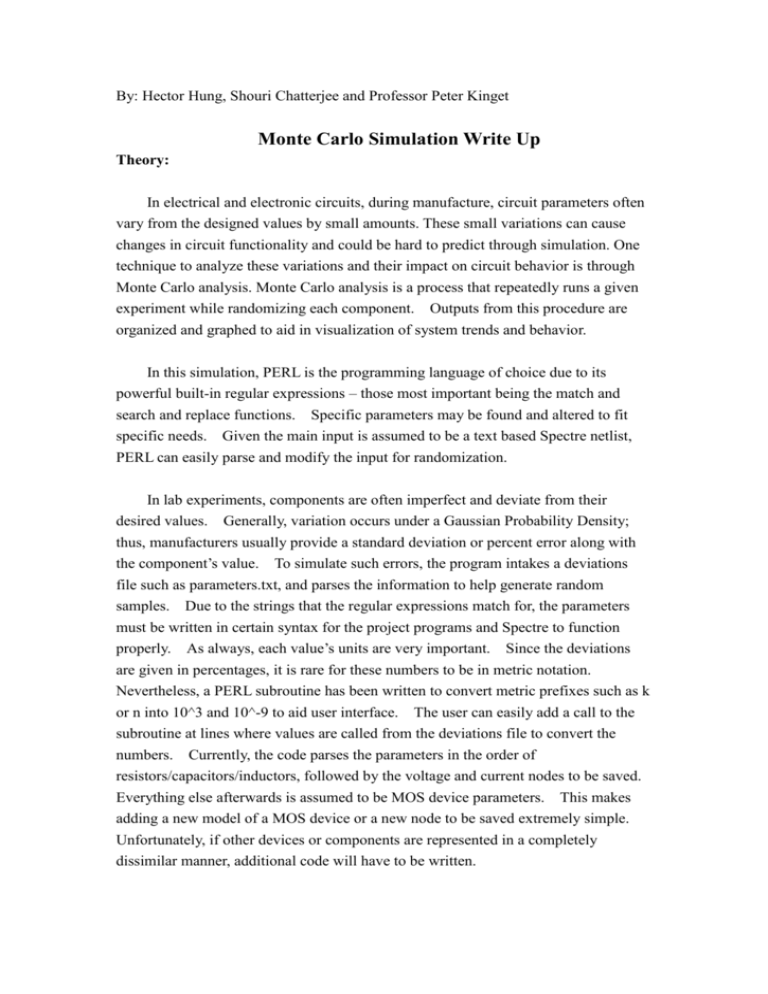
By: Hector Hung, Shouri Chatterjee and Professor Peter Kinget Monte Carlo Simulation Write Up Theory: In electrical and electronic circuits, during manufacture, circuit parameters often vary from the designed values by small amounts. These small variations can cause changes in circuit functionality and could be hard to predict through simulation. One technique to analyze these variations and their impact on circuit behavior is through Monte Carlo analysis. Monte Carlo analysis is a process that repeatedly runs a given experiment while randomizing each component. Outputs from this procedure are organized and graphed to aid in visualization of system trends and behavior. In this simulation, PERL is the programming language of choice due to its powerful built-in regular expressions – those most important being the match and search and replace functions. Specific parameters may be found and altered to fit specific needs. Given the main input is assumed to be a text based Spectre netlist, PERL can easily parse and modify the input for randomization. In lab experiments, components are often imperfect and deviate from their desired values. Generally, variation occurs under a Gaussian Probability Density; thus, manufacturers usually provide a standard deviation or percent error along with the component’s value. To simulate such errors, the program intakes a deviations file such as parameters.txt, and parses the information to help generate random samples. Due to the strings that the regular expressions match for, the parameters must be written in certain syntax for the project programs and Spectre to function properly. As always, each value’s units are very important. Since the deviations are given in percentages, it is rare for these numbers to be in metric notation. Nevertheless, a PERL subroutine has been written to convert metric prefixes such as k or n into 10^3 and 10^-9 to aid user interface. The user can easily add a call to the subroutine at lines where values are called from the deviations file to convert the numbers. Currently, the code parses the parameters in the order of resistors/capacitors/inductors, followed by the voltage and current nodes to be saved. Everything else afterwards is assumed to be MOS device parameters. This makes adding a new model of a MOS device or a new node to be saved extremely simple. Unfortunately, if other devices or components are represented in a completely dissimilar manner, additional code will have to be written. For the purposes of this simulation, it is assumed that all resistors are similarly manufactured with two kinds of error: deviation and shift. The shift error is a percentage used to simulate systematic error. All resistors shift by this amount. The deviation is a percent which scales the random number generated under the Gaussian PDF and is different for each resistor in each trial. Combining the sum of these two values with each resistor generates a new combined, randomized value. Similar mathematics is applied to capacitors and inductors. The next groups of values that are parsed from the deviations file are the voltage and current nodes. Firstly, the original save lines in the netlist are commented out and a new save line with the nodes listed in the nodes portion is printed. For further assistance on saving, refer to the example deviations file. The last group parsed is the models of the MOS devices. Every line contains parameters for a different model of the MOS. They can be typed in any order. Parameters are assumed to be zero if they do not exist. In modeling the MOS, we create a simple sub-circuit. There are two parameters we try to vary: mobility (μ) and Threshold Voltage (Vt). We vary μ by placing a current controlled current source parallel to the MOS’s drain and source terminal. It controls the drain source current with a gain of Δμ/μ. Given σ2 = AB2/(2WL), and using a formula which approximates of drain source current, we know that Ids is proportional to μ. I = W/L *μ f(VGS - Vt) becomes I = W/L 2 *(1+sqrt(AB /(2WL)))/ * f(VGS - Vt). Next we vary VGS by adding a voltage source ΔVGS between the input terminal and the gate terminal. We approximate σ2 = AVt2/(2WL), ΔVGS =ΔVVt + sqrt(AVt2/(2WL))Whenever this voltage goes up or down, it affects the threshold voltage and thus, the gate source voltage. The approximation formula becomes I = W/L * (1+sqrt(AB2/(2WL))) * f((VGS±ΔVVt + sqrt(AVt2/(2WL))) - Vt). Once again, let it be stressed upon the user how important units are. Project Programs: In this project, four files have been written in PERL: MCInputRandomizer, MCRunSpectre, MCOutputOrganizer and MCMakeGraph. MCInputRandomizer takes the input netlists and creates the requested number of random samples. MCRunSpectre uses Cadence’s Spectre to perform analysis on the netlist. Third, MCOutputOrganizer formats the results and places them in separate file. Each file is based on the node that it comes from. The first column is the result number; the second column is the time or frequency. Each column after represents a different trial. In addition, this program also calculates the average and standard deviation of each row. MCMakeGraph is a sample code for plotting our results using GNUPLOT. To run the MCInputRandomizer, type ./MCInputRandomizer <input_netlist.scs> <# of trials> <deviations file>. The program is defensive. It makes sure there are enough input parameters before proceeding. It also removes all files and the folder “results/”, and then creates a new empty folder to replace it. Users can change where outputs are stored by modifying the variable $resultpath on line 8. Next the program scans the deviations file using the &processDeviationsFile subroutine and save all available variable values. The deviation values for resistors, capacitors and inductors are set as variables, while the voltage and current nodes are set in arrays. The MOS models are set in an array. Each model also has a hash containing all values of the parameters. As the program obtains all background information prepared, it starts reading the input file to generate the randomized files. It names these generated files according to the input file. For example, if the input file is input.scs, the fourth trial will be named input4.scs. In the base case, input lines where regular expressions cannot match are copied verbatim. If the regular expressions match, this program assumes the component is found. For example, the program looks for something that starts with an “r” and ends with an “r=” to set as a resistor. As for the MOS’s, this program first matches for lines starting with M’s (please look at line 120 for the exact regular expression). The input line is split up into multiple portions: the Spectre name, the nodes it is attached to, the model number and its parameters. This line is replaced by a call to the MosModel’s subcircuit by adding an “I” in front of the MOS’s Spectre name. The MOS’s width and length values are also saved in order to create the ΔVGS and μ values. Lastly, the program searches for lines starting with “save”, and comments them out. Those lines are replaced by a save line of the function the user specifies in the deviations file. MCRunSpectre has a very simple task of going into the $RESULTPATH and running Spectre on any file ending in .scs and outputs them as .out files. For example, input1.scs will become input1.out. To use, type ./MCRunSpectre in the parent folder of the $RESULTPATH. MCOutputOrganizer looks for all .out files in the $RESULTPATH folder. This program has three modes. The first mode is used to skip the first few lines of code output by Spectre. The second mode scans the first input.out file in order to see how many variables or output files to make. The third mode saves the row number and time/frequency values into the first two columns of the two dimensional array $ReferenceArray. When this information is compiled, each row’s average value and standard deviation is calculated. Then, for reach variable of each trial, it puts each trial’s results into a column of the node’s ReferenceArray. Finally, all of this information is called up and printed into each nodes’ respective results file. For example, if there are 15 trials and net13 is to be saved, there will be a RESULTSnet13 file created. Inside, the first two columns will be row number, and time/frequency. The following 15 columns represent the values from the 15 simulations. Finally, it is important for the user to understand that only one type of analyses’ can be parsed. Therefore, if a transient response and an AC analysis are run, the results of both analyses will be stored in the same results file. Thus, it is highly recommended that only one analysis be run at a time. MCMakeGraph.pl requires a result file to plot. It also has built-it in options such as naming the x and y- axes. To run, type MCMakeGraph.pl –f <gnu file> -o <post script file> -t <graph title> -x <x label> -y <y label> [files]. This program parses the input, and looks for the specified options. If they exist, the program will save and use them when it runs GNUPLOT. These options can be inputted in any order as long as the options are listed. GNUPLOT is an extremely powerful plotting tool. Users can modify this PERL to add x and y error bars for multiple plots.
